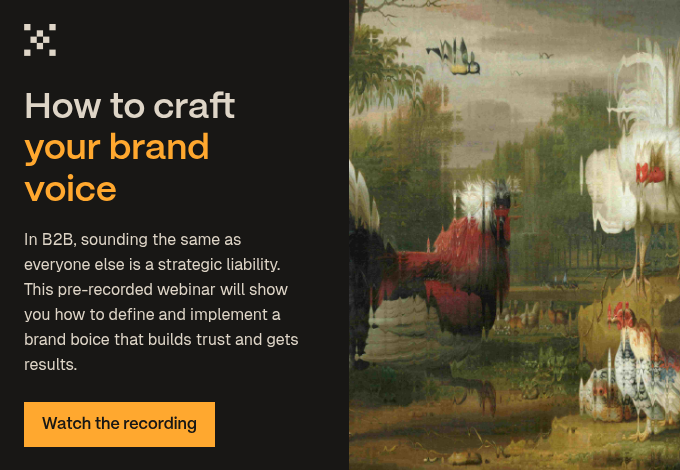‘Employer branding’ is the very specific work you do to position your business to employees — past, present and (crucially) future.
Plus, it says something about how you work, your talent acquisition and level of skill in the company, and your culture, all of which tend to matter to customers as well.
In that sense, it can be thought of as a subset of your main brand. It is perhaps most effective if there is some kind of connection between the two, though there doesn’t have to be.
The way we think about it, employer branding is an easier ‘in’ if you want to reposition your whole brand but don’t know where to start. There’s less risk. You can afford to experiment. It’s also something many businesses are more ready to try, and less likely to have already. There’s a shorter, clearer feedback loop as — unlike with your main brand positioning — you can measure its efficacy using fairly simple metrics, such as:
- Number of applicants
- Number of successful interviews
- Employee retention rate
- Employee engagement survey scores
- Employee churn rate
- Number of positive reviews from employees and leavers
- Post-employment engagement (returners, project work, partnerships, referrals, and so on)
The value of a great employer brand
There are two sides to this. Value to the employee and value to the employer.
Talented people are attracted to high salaries and good benefits, sure, but also culture, opportunities for career growth, contribution to the community, wellbeing support and so on. Employer branding is a promise that you make with a prospect, which, at its best, is a mutual agreement; a give-and-take. They provide their talents, you provide an environment where employees thrive.
Of course, there are things that may attract employees at first blush, like a company laptop. However, the deeper, more meaningful things, like mental health support in tough times, are what people really value.
It stands to reason you want to showcase the best you have to offer, which in itself helps to differentiate you from other businesses. Good pay, good benefits, evidence that employees have built their careers at your workplace — these things tell the world that you are a successful, well-run business. They speak to those deeper values.
In the end, by attracting the best talent to work in your organisation, you will inevitably stand out for other organisations in your sector because of the skills, creativity and drive of your employees. They bring differentiating capabilities into your business, allowing you to innovate more, do better work, sell more expertise and even open up new revenue streams.
People who love where they work will give their best, not their bare minimum. If you want to be the best provider in your industry, then you need the best talent, working to their full potential.
How to position your business as an attractive employer
Sadly, many organisations don’t give employer branding much thought. They think it’s just something that happens.
‘Of course people want this job, it’s got a great salary.’ Or, worse, ‘Of course they need this job, the economy is in the tank.’ This way of thinking omits events like the Great Resignation and the upheaval in the job market during the pandemic. It bypasses the changing attitudes to work, gig culture, entrepreneurship, remote work, and more. It’s blind to the realities of the modern job market.
In fact, at the time of writing at least, this is a buyers’ market. Prospective employees know their worth, and they are discerning about where they want to work.
So, as marketers, we invite you to approach your employer brand from a marketing angle. There’s something you’re offering (a job) and an audience (applicants). The gap between these two things is good old marketing, in our book.
To bridge this gap successfully, you need to establish the key messages that you want to get across. See if there is one ‘red thread’ connecting them or one that stands out from the rest as your most persuasive point.
Here are some ideas to get you started:
- We offer opportunities to learn and develop with training and mentorship
- Fostering a sense of belonging matters to our organisation
- We are committed to diversity, inclusion and equity
- Our team will help you realise your personal ambitions and career goals
- We encourage autonomy and innovation
- You will get to do challenging and rewarding work
- Everyone supports one another — you can make life-long friends here
- You will have a great work-life balance at our company
- Our business operates sustainably and has a positive impact on the community
We suggest tailoring these with specific proof points. For example, the first suggestion might be followed with, ‘by providing X number of paid training days and access to sought-after apprenticeships like yada yada.’
That way, you frame your messaging using that ‘start with why’ model. Start with the reason to believe, then talk about the hows and the whats. You can have a great work-life balance… because we pay this kind of salary and offer these holidays. We’re environmentally friendly… because we offset carbon for employees and encourage homeworking. You get the idea.
Actions, not promises
Once you have your messages and proof-points, and you’ve put that information out there on your website and other marketing channels, you do have to follow it up with actions.
Assume everyone you talk to will leave you a review on Glassdoor (they won’t, but assume it). That social proof matters.
So, consider how you treat candidates throughout the hiring process and ensure your promises don’t fall short. Be attentive and responsive, even to unsuccessful candidates. Lavish your successful ones with enthusiasm. Employer branding, done right, will help you build your dream team.

 Posted by
Maddy Leslie
Posted by
Maddy Leslie





.jpg?width=400&height=250&name=art-institute-of-chicago-pybByTGQ9zI-unsplash%201%20(1).jpg)
.jpg?width=400&height=250&name=museum-of-new-zealand-te-papa-tongarewa-tQG9yuNiCkc-unsplash%20(1).jpg)